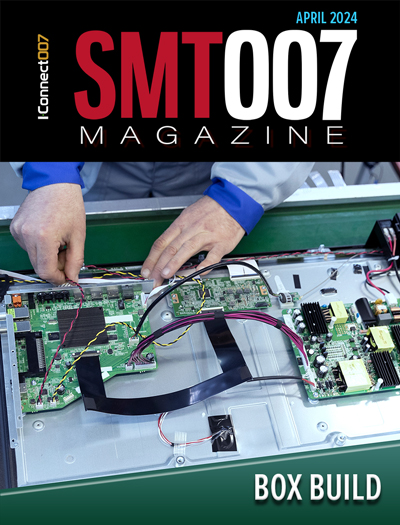-

- News
- Books
Featured Books
- smt007 Magazine
Latest Issues
Current Issue
Box Build
One trend is to add box build and final assembly to your product offering. In this issue, we explore the opportunities and risks of adding system assembly to your service portfolio.

IPC APEX EXPO 2024 Pre-show
This month’s issue devotes its pages to a comprehensive preview of the IPC APEX EXPO 2024 event. Whether your role is technical or business, if you're new-to-the-industry or seasoned veteran, you'll find value throughout this program.

Boost Your Sales
Every part of your business can be evaluated as a process, including your sales funnel. Optimizing your selling process requires a coordinated effort between marketing and sales. In this issue, industry experts in marketing and sales offer their best advice on how to boost your sales efforts.
- Articles
- Columns
Search Console
- Links
- Events
||| MENU - smt007 Magazine
Big Data Can Bring Your Business Back
April 20, 2022 | Zac Elliott, Siemens Digital Industries SoftwareEstimated reading time: 2 minutes
Let’s face it, in the past, electronics manufacturing has not been a big business for North America. A majority of electronics are assembled in Asia where supply chains and operating costs offer many economic advantages. In North America, the electronics manufacturing industry has been generally focused on lower volume, high-cost devices, while higher volume products are produced elsewhere. However, the COVID pandemic and various legislation in the U.S. are changing the situation, making electronics manufacturing in North America a more attractive option.
How can factories in North America compete for the same type of manufacturing traditionally performed in lower-cost regions? The answer is that they will not be competing, because they will not be performing the same type of manufacturing. Manufacturing is changing, and companies in North America are well positioned to work differently and surpass their global competitors.
What’s changing in manufacturing? Consumer trends related to the specialization and customization of products are moving the industry toward much smaller lot sizes. With a historical focus on higher mix production, manufacturers in North America have mastered the ability to provide their customers with responsiveness, flexibility, and quality. Carrying these capabilities forward is important to support the next generation of manufacturing.
How do manufacturers adapt? On the shop floor, manufacturing lines will become more modular to accommodate a higher mix of product on the same equipment, but what will really differentiate manufacturers is how they use data to support their operations. Leveraging data and digitalization will be the only way to maintain responsiveness, flexibility, and quality while supporting an increasing volume of high-mix products.
Boosting prediction accuracy is one of the key benefits of using data effectively, but this requires domain expertise and a deep understanding of the data. It also requires access to the data in the first place, and this is not always a trivial task. Many intelligent machine interfaces today will describe the processes and production operations occurring on the machine and allow for interlocking the equipment with external management systems. Most machines today do not provide information about their internal operation, and it is this detail that is needed to drive the next level of performance improvement, where a motor drawing extra power or a sensor operating marginally can signal a problem with the performance or reliability of the equipment. If that data is not available, companies can invest R&D resources to determine how to get to it.
To differentiate themselves from their competition, companies must provide intelligent, responsive, and supportive productization. Effectively balancing customization with complexity costs will allow companies to maintain profit margins significantly higher than their industry peers. Utilizing improved workflows and technology to maintain high output can provide a cost savings as compared to a mass production environment.
To read this entire article, which appeared in the April 2022 issue of SMT007 Magazine, click here.
Suggested Items
Warm Windows and Streamlined Skin Patches – IDTechEx Explores Flexible and Printed Electronics
04/26/2024 | IDTechExFlexible and printed electronics can be integrated into cars and homes to create modern aesthetics that are beneficial and easy to use. From luminous car controls to food labels that communicate the quality of food, the uses of this technology are endless and can upgrade many areas of everyday life.
Book Excerpt: The Printed Circuit Assembler’s Guide to... Factory Analytics
04/24/2024 | I-Connect007 Editorial TeamIn our fast-changing, deeply competitive, and margin-tight industry, factory analytics can be the key to unlocking untapped improvements to guarantee a thriving business. On top of that, electronics manufacturers are facing a tremendous burden to do more with less. If you don't already have a copy of this book, what follows is an excerpt from the introduction chapter of 'The Printed Circuit Assembler’s Guide to... Factory Analytics: Unlocking Efficiency Through Data Insights' to whet your appetite.
Listen Up! The Intricacies of PCB Drilling Detailed in New Podcast Episode
04/25/2024 | I-Connect007In episode 5 of the podcast series, On the Line With: Designing for Reality, Nolan Johnson and Matt Stevenson continue down the manufacturing process, this time focusing on the post-lamination drilling process for PCBs. Matt and Nolan delve into the intricacies of the PCB drilling process, highlighting the importance of hole quality, drill parameters, and design optimization to ensure smooth manufacturing. The conversation covers topics such as drill bit sizes, aspect ratios, vias, challenges in drilling, and ways to enhance efficiency in the drilling department.
Elevating PCB Design Engineering With IPC Programs
04/24/2024 | Cory Blaylock, IPCIn a monumental stride for the electronics manufacturing industry, IPC has successfully championed the recognition of the PCB Design Engineer as an official occupation by the U.S. Department of Labor (DOL). This pivotal achievement not only underscores the critical role of PCB design engineers within the technology landscape, but also marks the beginning of a transformative journey toward nurturing a robust, skilled workforce ready to propel our industry into the future.
Winner of The Science Show Rakett 69 Receives Incap Scholarship
04/24/2024 | IncapThe winner of the Rakett 69 science show, Andri Türkson, who stood out as an electronics enthusiast, received a scholarship from Incap Estonia, along with an internship opportunity in Saaremaa.


